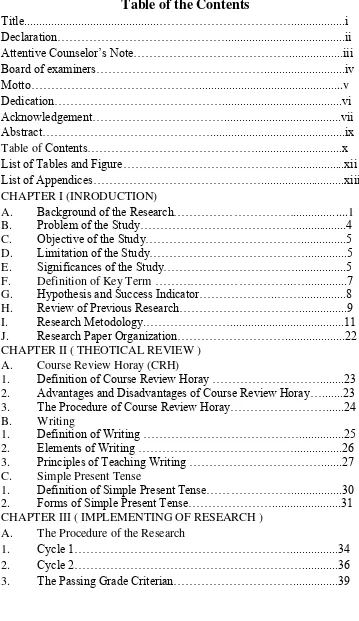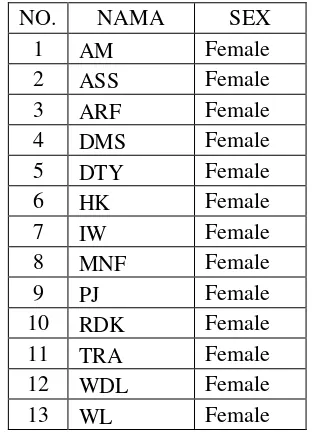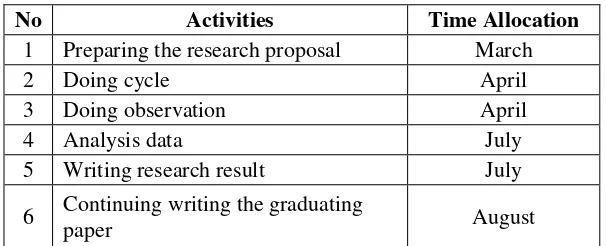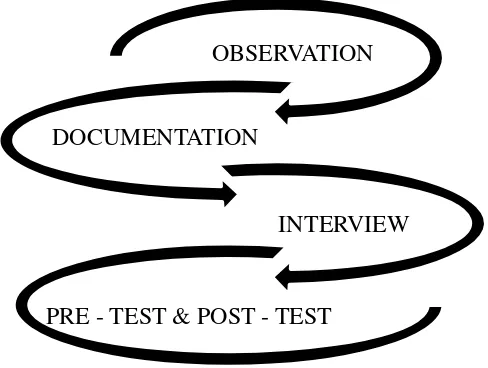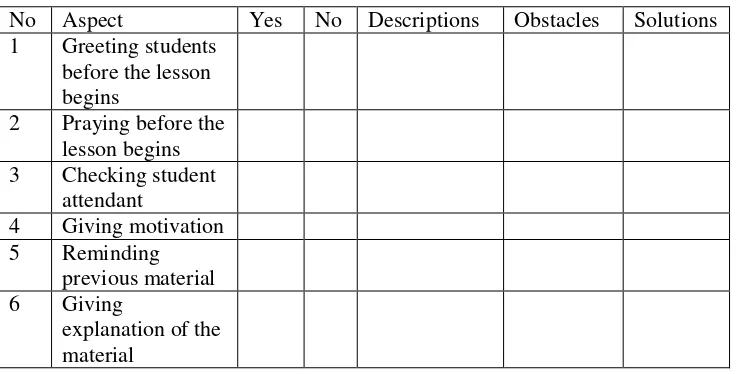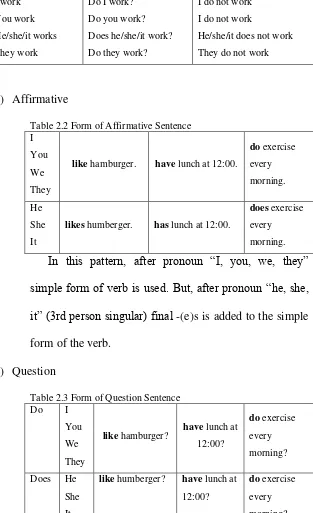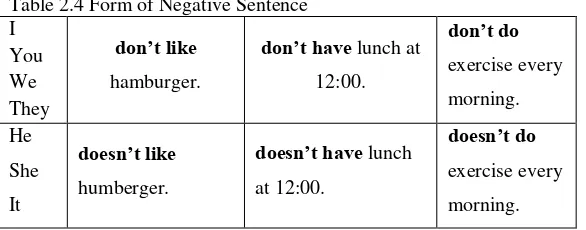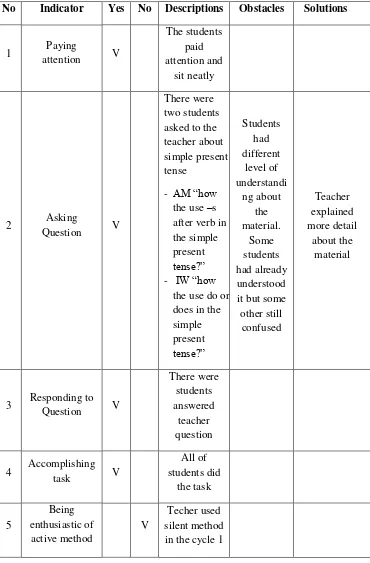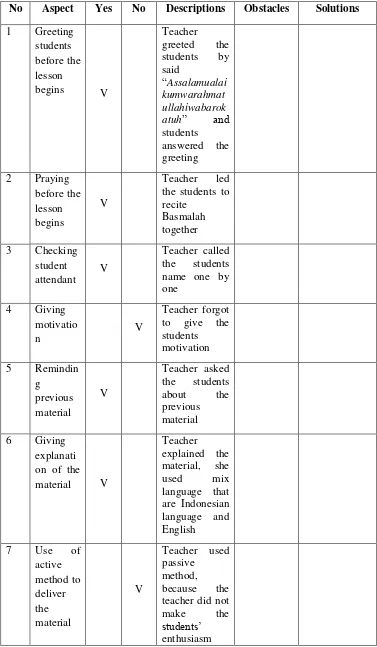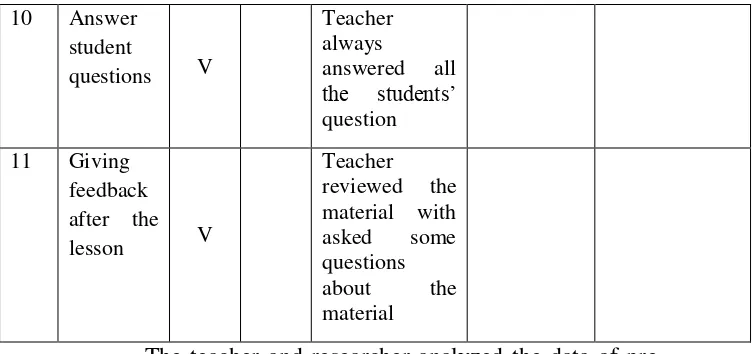i
THE USE OF
COURSE REVIEW HORAY
TO INCREASE
STUDENTS’ WRITING ABILITY IN SIMPLE PRESENT
TENSE (A Classroom Action Research at the Eleventh
Grade Students of SMK Muhammadiyah Salatiga in the
Academic Year of 2017/2018)
A Graduating Paper
Submitted to the Board of Examiners as a partial fulfillment of therequirements forthe degree of Sarjana Pendidikan (S.Pd.)
BY
IRMA INNAYATI FAUZIYYAH
113
–
14
–
021
ENGLISH EDUCATION DEPARTMENT TEACHERTRAINING AND EDUCATION FACULTY STATE INSTITUTE FOR ISLAMIC STUDIES (IAIN) SALATIGA
v
MOTTO
“Write to be understood, speak to be heard, read to
grow.”
vi
DEDICATION
This graduating paper is dedicated to:
1. My beloved parents Mr. Wahjoe H P and Mrs. Wahjoe H P, who
always love and support me. You are my inspiration and my
everything.
2. My beloved little brother M. Irfandi Azis who always support me.
3. My big family that supported for my education and finishing this
graduating paper.
4. My lecturer who always guide me to correct my graduation paper.
5. The English teacher of SMK Muhammadiyah Salatiga
6. My best friend Melani Enggarsari who alway support and motivate
me to finish my graduation paper.
7. My friends in IAIN Salatiga Widiyastuti, Siti Fatimah, Diyah Tri
Hastutik and all of my friends that I can not mention one by one for
helped and support me to finish my graduation paper.
vii
ACKNOWLEDGEMENT
Bismillahirrahmanirrahim,
Assalamu’alaikum Wr. Wb.
Alhamdulillahirobbil’alamin, all praise be to Allah SWT, the Most
Gracious and the Most Merciful who always bless and help the writer so the
writer can finish the graduating paper requirement for the Degree of Sarjana
Pendidikan (S.Pd.) in English Department of Teacher Training and
Education Faculty State Institute for Islamic Studies Salatiga. Bless and
mercy is upon great Prophet Muhammad SAW for his guidance that leads
the writer to the truth.
However, this paper will not be finished without support, advices,
help and encouragement from several people and institution. Hence, the ter
would like to express special thanks to:
1. Dr. Rahmat Haryadi, M.Pd, the Rector of Institute of Islamic Studies
(IAIN) of Salatiga.
2. Suwardi, M.Pd, the Dean of Teacher Training and Education Faculty
of State Institute for Islamic Studies (IAIN) of Salatiga.
3. Noor Malihah, Ph.D, the Head of English Education Department
4. Hammam, S.Pd., M.Pd., Ph.D. the counselor of this paper, who gives
great attention, suggestion and guidance for this paper from
beginning until the end.
5. All of the lecturers in English Education Department of Teacher
ix ABSTRACT
Fauziyyah, Irma Innayati. 2018. The Use of Corse Review Horay To Increase Students’ Writing Ability in Simple Present Tense (A Classroom Action Research at the Eleventh Grade Students of SMK Muhammadiyah Salatiga in the Academic Year of 2017/2018). A Graduating Paper. English Education Department. Teacher Training and Education Faculty.Institute State of Islamic Studies (IAIN) Salatiga.Counselor: Hammam, S.Pd., M.Pd., Ph.D.
This is a Classroom Action Research (CAR). The problem statement of this research is how the use of Course Review Horayto increase students‟ writing ability and how significant is the result of using Course Review
Horay to increase students‟ writing ability.
Data collection methods are observation, interview, documentation, and test. The subject of this research study is eleventh grade students of Garment class in SMK Muhammdiyah Salatiga at academic year 2017/2018.
Based on this research calculation that the average value during the pretest is 70,5 which is incrased significantlywhile in the average of the post
– test value is 86,8. It can be concluded that the use of Course Review Horay method is effective to increase students‟ writing ability in Simple Present Tense for eleventh grade students of SMK Muhammadiyah Salatiga in the academic year of 2017/2018.
x
Table of the Contents
Title...………...i
List of Tables and Figure………...xii
List of Appendices………...xiii
CHAPTER I (INRODUCTION) A. Background of the Research………...1
B. Problem of the Study………...4
C. Objective of the Study………...5
D. Limitation of the Study………...5
E. Significances of the Study………...5
F. Definition of Key Term ………..…...7
G. Hypothesis and Success Indicator………..……...8
H. Review of Previous Research………...9
I. Research Metodology.………...11
J. Research Paper Organization………...22
CHAPTER II ( THEOTICAL REVIEW ) A. Course Review Horay (CRH) 1. Definition of Course Review Horay ………...23
2. Advantages and Disadvantages of Course Review Horay…...23
3. The Procedure of Course Review Horay………...24
B. Writing 1. Definition of Writing ………...25
2. Elements of Writing ………...26
3. Principles of Teaching Writing ………...27
C. Simple Present Tense 1. Definition of Simple Present Tense………...30
2. Forms of Simple Present Tense………...31
CHAPTER III ( IMPLEMENTING OF RESEARCH ) A. The Procedure of the Research 1. Cycle 1………...34
2. Cycle 2………...36
xi
CHAPTER IV (RESEARCH FINDING AND DATA ANALYSIS ) A. The Result of the Research
1. Research Finding
a. Cycle 1………...40 b. Cycle 2………...56 2. Discussion………...71 CHAPTER V(CLOSURE)
A. Conclusions………...74
B. Suggestions ………...76
xii
LIST OF TABLE AND FIGURE
Figure 1.1 Research Design ... 11
Figure 1.2 Data Collection Methods ... 14
Table 1.1 List of XI TB (Tata Busana) ... 12
Table 1.2: Research Schedule ... 13
Tabel 1. 3: Form of Observation Check List for students ... 15
Table 1.4 : Form of Observation Check List for Teacher ... 15
Table 2.1 Forms of Simple Present Tense ... 31
Table 2.2 Form of Affirmative Sentence ... 32
Table 2.3 Form of Question Sentence ... 32
Table 2.4 Form of Negative Sentence ... 32
Table 4. 1: Form of Result Observation Check List for Students ... 45
Table 4. 2: Form of Result Observation Check List for Teacher ... 46
Table 4. 3: Students‟ Score in the Pre-test of the Cycle I ... 48
Table 4. 4: Count of Passing Grade of the Pre-test in the Cycle I ... 48
Table 4. 5: Students‟ Score in the Post-test of the Cycle I ... 49
Table 4. 6: Count of Passing Grade of the Post-test in the Cycle I ... 50
Table 4. 7: Difference Square of Pre and Post-test Score in Cycle I ... 50
Table 4. 8: Form of Result Observation Check List for Students ... 61
Table 4. 9: Form of Result Observation Check List for Teacher ... 62
Table 4. 10: Students‟ Score in the Pre-test of the Cycle II ... 64
Table 4. 11: Count of Passing Grade of the Pre-test in the Cycle II ... 65
Table 4. 12: Students‟ Score in the Post-test of the Cycle II ... 65
Table 4. 13: Count of Passing Grade of the Post-test in the Cycle II ... 66
Table 4.14: Difference Square of Pre and Post-test Score in Cycle II ... 66
xiii
LIST OF APPENDICES
1. Syllabus of Eleventh Grade Students‟ of SMK Muhammadiyah Salatiga
2. Lesson plan of Cycle 1 3. Lesson plan of Cycle 2
4. The result of Pre - TestCycle 1 5. The result of Post – Test Cycle 1 6. The result of Pre – Test Cycle 2 7. The result of Post – Test Cycle 2
8. Photos Documentation of Cycle 1 & Cycle 2 9. Certification For Graduating Counselor 10.Letter for Research Permission
1
CHAPTER 1
INTRODUCTION
In this chapter the researcher presents background of the research,
research question, objective of the research, limitation of the research,
significance of the research, definition of key terms, hypothesis, research of
methodology and graduating paper outlines.
A.Background of the Study
Language is communication tool that used by human being in our
daily life. It is as signaling symbol to express and share their thought or
ideas with others orally or written. Language is a purely human and non
– instinctive method of communicating ideas, emotions, and desires by
means of a system of voluntarily produced symbol (Sapir, 1921:8).
People used language as a tool for interaction in their daily life. Everyone
is aware that the interaction and all sorts of activities in society would be
paralyzed without language. The functions of language are to declare self
– expression, as a tool in communication, as a tool to conduct
interrogation and social adaption. By language people can express their
opinion, feelings, ideas, comment, suggestion, advice, thoughts and they
can share their experience and etc.
In English, there are four skills that should be mastered, they are:
listening, speaking, reading, and writing. The writing skill becomes very
important in the education field, students need to be exercised and trained
2
that should be improved and mastered by students. According to Gelb
(1962: 11), writing began at the time when man learned how to
communicate his thought and feelings by means of visible sign,
understandable not only to himself but also to all other persons more or
less initiated into the particular system. Writing has been with us for
several thousand years, and nowadays is more important than ever.
Writing does not only offer ways of reclaiming the past, but it also a
critical skill for shaping the future. Writing is secondary to and
dependent on speech and, therefore, deserves to be investigated only as a
means of analyzing speech. This is the gist of Aristotle‟s definition of
writing, which became axiomatic in the Western tradition.
Generally, writing is always related with grammar. Grammar is a
theory of language, of how language is put together and how it works
(Gerot and Wignell, 1995, as cited in Hartono, 2018:2). Grammar covers
noun, pronoun, adjectives, verb, modals, preposition, tenses and other
structure items. Grammar is probably one problem for the students to
write but it is very important, because we need grammar to write anyting
in English. Grammar is also a basic knowledge to understand English
perfectly. There are sixteen pattern that we know in English grammar.
One of the pattern is Simple Present Tense. The researcher will focus her
research in study Simple Present Tense. By mastering grammar correctly,
it can be ascertained that one can writeEnglish well and also true.
Based on my observation and result of my interview with Mrs. Risda
3
researcher found that students get some difficulties in writting especially
on Grammar. They have problem about how to use Simple Present
Tense. The researcher observed that the problem might be caused by
several factors: 1. The students did not mastery a lot of vocabularies. 2.
The students feel bored in following teaching learning activities. 3. The
students did not understand the grammar well.
Based on my explanation above then it is necessary to find out a way
to overcome the problem. The researcher assume that the problems is
probably about the way teacher deliver the material. One solution in this
problem is using different method that make learning situajtion became
active. Learning method is a strategy which is applied by teacher in
teaching to increase motivation and student‟s interest in studying. Course
Review Horay (CRH) is one of a learning method which can create
exciting and fun class atmosphere because every student who has right
answer must shout “Horay!” or another preferably yells (Huda, 2013:
229). That learning method emphasizes to student‟s comprehension test
in answering question. The task is done in small group. CRH can make
the class more lively and fun because students will have interaction with
their friends in group and accept the learning content from the teacher.
CRH is suitable for students that do not have many interesting to
learn English, because it this method can help them to increase their
interest in English studying. The result of research by Hermawan,
Kamsiyati, and Atmojo (2012) said that CRH method is not only want
4
student to reach social relationship purposes which can influence their
academic achievement in school. Result of another research by Kasna,
Sudhita and Rati (2015) which reveals CRH method has positive impact
in students learning completeness. The result found that student pay more
attention when the lesson was lasting, learning condition was more
conducive, and student‟s learning enthusiasm increased. Increased
student‟s studying interest influences in increasing their learning
completeness value.
Many result of researches show that CRH method can increase
students‟ ability and learning achievement. Based on those statements,
researcher was interested to do a research entitled “The Use of Course
Review Horay to Increase Students’ Writing Ability in Simple Present
Tense (A Classroom Action Research at the Eleventh Grade Students of
SMK Muhammadiyah Salatiga in the Academic Year of 2017/2018)”.
B. Problems of the Study
Based on the explanation above, this research aimed to
answer the following problem:
1. How does the use of Course Review Horay to increase students‟
writing ability?
2. How significant is the result of using Course Review Horay to
5 C. Objects of the Study
The general purpose of research is to find the degree of
Course Review Horay that is suitable with class condition. The
specific objectives of this research are:
1. To identify the use of course review horay to increase students
writing ability.
2. To find out how significant is the result of using course review
horay to increase students‟ writing ability.
D. Limitation of the Study
The emphasis researches on the use of Course Review Horay
(CRH) to increase students‟ writing ability. In order to focus this
research, the writer limits the study as follow: The research is
limited in using Course Review Horay (CRH), the research is limited
in writing ability, and the research is carried out to the eleventh
grade of SMK Muhammadiayah Salatiga in the academic years
2017/2018.
E. Significances of the Study
This research is hoped that it will be useful for the teachers,
students, and researches. It is conducted in order to give theoretical
6
1. Theoretical benefit
a. The language teaching dealing with teaching method.
b. The English language teaching method especially Course
Review Horay (CRH) for other researcher to conduct further
researches.
2. Practical benefit
a. Writer
The research contributes to the researcher to find out
the best method to increase writing ability.
b. Students
The research helps students to increase their writing
ability and makes them more understand about the materials.
c. Teachers
This research gives additional contribution to English
teachers to develop language teaching method and
practically, and this study will contribute the teachers in their
English class. So, they are able to increase students‟ writing
ability.
d. Institution
The result of the research contributes the institution to
7 F. Definition of Key Term
1. Course Review Horay (CRH)
Course Review Horay (CRH) is a learning method which can
create exciting and fun class atmosphere because every student
who has right answer must shout “Horay!” or another preferably
yells (Huda, 2013: 229). That learning method emphasizes to
student‟s comprehension test in answering question. The task is
done in small group. CRH can make the class more lively and
fun because students will have interaction with their friends in
group and accept the learning content from the teacher.
2. Simple Present Tense
In English grammar, the simple present tense is a form of the
verb that refers to an action or event that is ongoing or that
regularly takes place in present time. For example, in the
sentence "he cries easily," the verb "cries" is an ongoing action
that he easily does. We use the simple present tense when an
action is happening right now, or when it happens regularly (or
unceasingly, which is why it‟s sometimes called present
indefinite). Depending on the person, the simple present tense is
formed by using the root form or by adding ‑s or ‑es to the end.
3. Writing
According to (Leo, 2007, as cited Nazil, 2018: 8) writing is a
process of expressing ideas or thoughts in words should be done
8
grammatically correct sentences by manipulating words in the
form of a piece of continuous writing with successfully
communicates the writer‟s ideas on a certain topic (Heaton,
1975, as cited Nazil, 2018:8). Writing is one of the four language
skills: reading, writing, speaking, and listening. Writing involves
communicating a message (something to say) by making a sign
on a page (Williams, 2005, as cited Nazil, 2018:8). Writing is a
process of expressing ideas or thoughts into writing.
G. Hypothesis and Success Indicator
Based on the students observation result in simple present
tense mastery as illustrated in chapter 1, the researcher tries to
overcome those problems by using course review horay method. By
conducting this research, the researcher proposes a hypothesis: The
use of course review horay method can improve the students‟
understanding on simple present tense.
The success indicator of this research is taken from the
students‟ Basic Competence/ability shown in Lesson Plan (RPP)
(see appendix 2). The students‟ success and failure in doing the
activities in cycle I and II will be assess by referring to the criterion
of passing grade (KKM). The passing grade of English lesson in
SMK Muhammadiyah Salatiga is 77. The teacher and the researcher
expect that there are at least 80 % of the students who pass the
9 H. Review of Previous Research
In this research, the writer takes some review from other
research as a comparative in this research. The first research was
conducted by Bagas Narendra Parahita (2014) with the title
“Penerapan Model Pembelajaran Kooperative Tipe Course Review
Horay Untuk Meningkatkan Hasil Belajar Sosiologi Siswa Kelas XI
IPS 1 SMA Muhammadiyah 1 Surakarta Tahun Pelajaran
2013/2014”. The purpose of this research is to improve sociology
learning outcomes by applying cooperative learning model Course
Review Horay in second grade of IPS 1 SMA Muhammadiyah 1
Surakarta Academic Year of 2013/2014.This research used
classroom action research as the method. It is consisting of two
cycles and each cycle consists of 4 stages: planning, implementation,
observation and reflection. The research participants were the
students of XI IPS 1 class which amounted to 30 people.
The second research hasbeen done by Nadia Devina Arya
Putri, Abdul Salim, and Sunardi (2017) entitled “The Effectiveness
of the Use of Cojurse Review Horay (CRH) Methods to Improve
Numeracy Division Skill oV Childern with Mild Mental Retardation
in SLB Negeri Surakarta, Indonesia Year 20162017”. This research
aimed to investigate the effectiveness of the use of Course Review
Horay (CRH) methods to improve numeracy division skill of
childern with mild mental retardation in class IV of SLB Negeri
11
This study used a quantitative approach with Pre –
Experimental type (One Group Pretest – Posttest Design). The
subject was six students with mild mental retardation from class IV.
The data of this research was collected by test. Based on the
calculation using SPSS 23, found that the average value during the
pretest was 51,67 which experienced a significant increase in the
average posttest value was 76,67. It can be concluded that the use of
CRH method is effective to improve numeracy division skill of
childern with mild mental retardation in class IV of SLB Negeri
Surakarta in the academic years of 2016/2017.
The third research has done by Dewi Rahimah and Syafdi
Maizora (2014) entitled “The Implementation of Cooperative
Learning Course Review Horay Type Aided Macromedia Flash
Media in Integral Calculus Course”. This study wants to examine
the implementation of cooperative learning course review horay type
aided macromedia flash media to increase students‟ active learning,
responses, and learning outcomes in integral calculus course. This
study used Classroom Action Research (CAR) as the method of
research. Data collection technique use observation, questionnaires,
and test. The data was analyzed descriptively. The subjects of this
research study are students taking integral calculus course in Study
Program of Mathematics Education, Faculty of Teacher Training and
Education, the University of Bengkulu, in Semester III Class A at
12
The similiarities of the previous study is they applied
cooperative technieque type Course Review Horay (CRH). The
differencess from three previous study are the subject and object of
the research. The subject of the research is Simple Present Tense and
the object of the research are students in SMK Muhammadiyah
Salatiga.
I. Research Methodology
1. Research Design
Figure 1.1 Research Design
Kurt Lewin's model becomes the basic or basic reference of
the existence of other models of action research, especially
Classroom Action Research. Through he was the first person
whose introduce Action Research model. The main concept of
action research Kurt Lewin model consists of four components,
namely; a) planning, b) acting, c) observing, and d) reflecting.
a. Planning, in this step, the researcher focuses on who, what,
when, where, and how the action is conducted.
b. Acting, in this step conducted to implement the strategies
13
c. Observing, in this step the observer do an observation. When
the observer is the teacher concerned, it must do a
"back-sight" of what happens when the action takes place.
d. Reflecting, reflection means to analyze the result based on
the data that have been collected to determine the next action
in the next cycle.
2. Subject of the Research
The subject of this research is the Second grade students of
SMK Muhammadiyah Salatiga in the academic year of
2017/2018. It consists of 13 students.
Table 1. 1: List of XI TB (Tata Busana)
NO. NAMA SEX
1 AM Female
2 ASS Female
3 ARF Female
4 DMS Female
5 DTY Female
6 HK Female
7 IW Female
8 MNF Female
9 PJ Female
10 RDK Female
11 TRA Female
12 WDL Female
14
3. Steps of the Research
In conducting the research, the researchers carry out the
steps which summarized in the following research schedule. The
research schedule is shown in the table 1. 2.
Table 1.2: Research Schedule
No Activities Time Allocation
1 Preparing the research proposal March
2 Doing cycle April
3 Doing observation April
4 Analysis data July
5 Writing research result July
6 Continuing writing the graduating
paper August
4. Data Collection Method and Research Instrument
Collecting data is important to conduct a research. Arikunto
(2010: 265) explains that there are some methods of collecting
data. There are questionare, test, observation, interview and
documentation. In order to collect data, the researcher uses four
of them by using observation, documentation, interview and test
as an instrument. Furthermore, Arikunto (2010: 192) states an
instrument is the tool or facilities that is used by the researcher to
15
Figure 1.2 Data Collection Methods
There are some research methods that the writer use to collect
the data:
a. Observation
Arikunto defined (2010:199) observation is a method
of collectiong data which focus on an object using all of the
five human‟s senses. In this classroom observation, the
researcher observe students and teacher activities in Simple
Present Tense teaching learning. The researcher do her
observation at April 4, 2018 in second grade students of
SMK Muhammadiyah Salatiga.The researcher uses this
method to know the students directly within the teaching
learning activity as well as in the school area.
The next checklist is a checklist that is used to
observe the teacher. This is about the teacher activity in the
learning process in the classroom. The teacher activity here
are opening the lesson, giving assignment, delivering OBSERVATION
DOCUMENTATION
INTERVIEW
16
material of learning objectives, using media which
accordance with the material, creating an exciting learning
environment, generating students interest in learning, helping
student‟s difficulties during learning, being fair to all
students, answering student questions, and ending end the
lesson (see table 1. 3). In filling this observation teacher,
check list use mark “√”.
Tabel 1. 3: Form of Observation Check List for students
No Indicator Yes No Descriptions Obstacles Solutions
1 Paying attention
2
Table 1. 4 Form of Observation Check List for Teacher
No Aspect Yes No Descriptions Obstacles Solutions
1 Greeting students before the lesson begins
2 Praying before the lesson begins 3 Checking student
17
10 Answers student questions 11 Giving feedback
after the lesson
b. Documentation
In this research, documentations are all recording
materials during the research. The documentations are
photos, videos, paper test, classroom data (e.g. list of
students name). From the result of documentation, we can
made it as guidance consideration of further implementation
and drawing conclusions.
c. Interview
Nazilah cites in her graduating paper McNamara
(1999) Interviews are particularly useful for getting the story
behind a participant‟s experiences. The interviewer can
pursue in-depth information around the topic. Interviews may
be useful as follow-up to certain. The researcher conducted
two interviews. The first, the researcher interviewed the
English teacher on April 3, 2018 to find out the difficulties
18
interviewed several students in the same day to find out their
shortcomings and difficulties while learning English.
d. Test
A test is a method for collecting data by using
questions. Hartono also assumes Heaton (1975: 1), Test is
important part of every teaching and learning experience.
Both testing and teaching are so closely interrelated that it is
virtually impossible to work in either field without being
constantly concerned with the other. Tests may be construct
primarily as devices to reinforce learning and to motivate the
students‟ performance in the language.
The researcher uses two type of test, there are Pre –
Test and Post – Test. Pre – test was did before treatment that
was given to know how far the students writig skill. The test
consist of nine queations that the teacher given. Whille post –
test given after the teacher was giving the treatment. The test
consist of nine questions. The researcher uses this method to
determine the success rate of learning methods that teachers
use on the students‟ writing skill.
5. Method of Analysis Data
Data analysis is specific aspect of the reflectivity of action
research. The research point of view was in the data analysis
result. The whole points of action research was that analyzed the
19
constantly feed back into practice. The researcher used
descriptive analysis and statistical technique.
1. Descriptive Analysis
The descriptive analysis was used to analyze the data
of point written in the lesson plan. Descriptive analysis is
used to describe the basic features of the data in the study.
Descriptive analysis of data limits generalization to a
particular group of individuals observed. No conclusions
extend beyond this group and any similarity to those outside
the group cannot be assumed. The data describe one group
and that group only.
2. Statistical Technique
In this research, the writer also presents quantitative
data by using statistical technique to support the result of
research. To know the progress in pre-test and post-test, she
employs pre – test and post – test by formula in the following
20
a. To find out the mean score of the pre test and the post
test, the researcher used this formula :
∑X M =
N
Note:
M= The Mean of the students score.
∑ X= The sum of the students score.
N= The total number of the students
b. To calculate the t-test, the researcher used this formula :
MD To =
SEMD
Note:
To = T – test.
MD = Mean of difference.
SEMD = The standard error for the mean difference.
c. To calculate standard deviation, the reseacher used this
fourmula:
∑D2 ∑D 2 SDD =
N N
Note:
SDD =Standard Deviation.
D =The Difference between the pre test and the
21
N =The number of the students.
d. To calculate the standard error for the mean difference,
the researcher used this formula:
SDD SEMD=
N-1
Note:
SEMD =The standard error for the mean difference.
SDD = Standard Deviation.
N = The total number of the students.
d.f= N-1
e. To calculate the t-test, the researcher used this formula :
MD T0 =
SEMD
Note:
To = T – test.
MD = Mean of difference.
SEMD = The standard error for the mean difference.
The students' score of pre-test and post-test obtained
from the process are used to see the progress of understanding
and the students' achievement.
The formula was used to know successful or not as
follows
22
%X =
Note:
%X = the percentage of individual success
X1 = obtained score
N = the maximum score
The researcher compares the result with criteria of
success. If the percentage of success is 80% or more, it means
that the class was successful. But the percentage of success
23 J. Research Paper Organization
The researcher arranges the graduating paper in order to the
readers can catch the content easily. It is divided into five chapters.
Chapter I is introduction. In this chapter, the researcher
comes up to background of the study, problems of the study, objects
of the study, limitation of the study, significances of the study,
definition of the key term, hypothesis and success indikator, review
of previous research, research methodology, and also research paper
organization.
Chapter II is theoretical framework. It consists of the
underlying theories that include the definition of writing, definition
of Course Review Horay (CRH), implementation of Course Review
Horay (CRH), definition of Descriptive Text, and the expectation
toward writing ability.
Chapter III explains about Methodology of the research, the
setting of the research, subject the research, type of the research,
procedures of the research, technique of collecting data, and
technique of analyzing data.
Chapter IV is data analysis which consists of the description
from cycle I up to cycle II, result and discussion of the research. It
contains process and result score of the research in each cycle.
Chapter V is closure that consists of conclusions and
24
CHAPTER II
THEORETICAL REVIEW
A. Course Review Horay (CRH)
1. Definition of Course Review Horay (CRH)
Course Review Horay (CRH) is a type of cooperative
learning that emphasizes understanding of students in solving
problems, in which answers are typed in boxes (Sugandi &
Rahayu, 2012, as cited Dewi, 2014:2). Course Review Horay
(CRH) is a learning method which can create exciting and fun
class atmosphere because every student who has right answer
must shout “Horay!” or another preferably yells (Huda, 2013:
229).That learning method emphasizes to students‟
comprehension test in answering question. The task is done in
small group.
Based on the explanation of the experts above, the learning
model of Course Review Horay (CRH) is a model or design
learning to test students' understanding by using strategy games
where if students are able to answer correctly then the students
will shout '' horey ''. CRH is suitable for children with mental
retardation because it can increase interest in English studiyng.
2. Advantages and Disadvantages of Course Review Horay (CRH)
The advantages of this method are ; 1. The structure is
interesting and can encourage students to be able to plunge into
25
with entertainment, so the atmosphere is not surprising. 3.
Increased learning spirit because of the fun learning atmosphere.
4. Increased skill of student cooperation. Kasna, Sudhita and Rati
(2015) said that which reveals CRH method has positive impact
in student learning completeness. In other hands, there are some
disadvantages of CRH method; 1. Leveling values between
active students and passive students. 2. An opportunity to cheat.
3. at risk of disrupting the learning of other classes. Many results
of researches show that CRH method can increase student
learning motivation and learning achivement. For realized it,
students expected to has good writing ability.
3. The Procedure of Course Review Horay (CRH)
According to Uno and Mohamad in Saur Tampubolon‟s book
(2011: 126) are as follows: (1) Lecturers convey competence to
be achieved; (2) Lecturer demonstrating/presenting the material;
(3) Giving students the opportunity debriefing; (4) To test
comprehension, students were told to make a box 16/09/25 suits
needs and each box is filled with a number; (5) Lecturers read
questions randomly and students write the answers in the box
whose number is mentioned by lecturers and directly discussed,
if the answer is true, fill mark (V) and if the answer is false, fill a
cross (x); (6) Students who have got marks V vertical,
26
Students‟ value calculated from the number of correct answers
27
B. Writing
a. Definition of Writing
Language is primarily speech and writing is a means to
preserve it. Writing is a kind of linguistic behaviour; a picture is
not. It presents the sounds of language through visual symbols.
Writing may be very important for one group of students but
much less important for others. The decision on how much
writing to include will be made independently according to the
needs of each group of students.
According to (Rivers, 1981, as cited in Hartono, 2018:20),
writing is conveying information or expression of originalideas
in a consecutive way in the new language. Brown, (2001, as
cited in Hartono, 2018:20) also claimedthat writing is a thinking
process. Furthermore, he states that writing can beplanned and
given with an unlimited number of revisions before its release. In
addition, (Elbow, 1973, as cited in Hartono, 2018:20) also says
that writing is a two-stepprocess. The first process is figuring out
the meaning and the second process is putting the meaning into
language. Writing represents what we think. It is because the
writing process reflects things, which stay in the mind. Students
who are reluctant to write things down often suffer for this
activity. The students find difficulties when they start looking for
28
b. Elements of Writing
Based on Braden Cobb in a book entitled “Five Elements of
Good Writing –Unit 2”, there are five elements of good writing:
a. Purpose
A purpose statement is a short sentence that clearly
defines the point of the paragraph. Reviewing the purpose
statement while you write will help you to stay on topic and
maintain the focus of your writing. Some writers attach index
cards or “sticky notes” on their computer screens to keep the
goal of the writing within easy view.
When we talk about the purpose of a paragraph, we
are talking about the reasons that a writer is writing a
particular paragraph. For writers to stay focused on their
topic, they must understand the purpose that they are trying
to accomplish. The purpose is the goal the writer is trying to
achieve. The three most common goals of academic writing
are: to inform the readers,. to persuade the readers, to
entertain the readers.
b. Audience
The second element of good writing is to keep your
audience in mind as you write. The term audience refers to
the readers. Good writers know who their audience is before
they start writing. Good writers keep their audience in mind
29
c. Clarity
Clarity refers to how easy it is for the reader to
understand your writing. Good writers explain their points
clearly. Clear sentences are not vague or indirect; they get the
point across to the reader by using specific, concise language.
Here are two ways that you can improve clarity; use
descriptive (or precise) words, use clear pronoun references.
d. Unity
Unity in a paragraph means that all the sentences are
related to the topic sentence and its controlling idea. Good
writers stay on topic by making sure that each supporting
sentence relates to the topic sentence.
e. Coherence
A piece of writing has coherence when all of the
ideas are organized and flow smoothly and logically from
one to the next. When a paragraph or essay has coherence,
the reader can follow the main ideas more easily. Three
important features of coherence are: logical order, repetition
of key words, use of transitional words and phrases.
c. Principles of Teaching Writing
Here are the principles (described in more detail in
Hoffman‟s and Wexler‟s forthcoming book, The Writing
Revolution, Jossey-Bass, August 2017):
30
Being a good reader is not enough to become a good
writer; writing requires far more decisions.Students need to
be taught how the conventions of written language differ
from those of spoken language, communicating with much
more precision and clarity, anticipating what the reader needs
to know and understand, and using punctuation and key
words (despite, although, for example, specifically) to
indicate nuances in meaning, connections, and breaks in the
narrative. It‟s also important that they avoid errors in spelling
and grammar that will distract readers. All this needs to begin
in the early elementary grades, and although it‟s important
that students enjoy writing and get to use it as a means of
self-expression, there should be plenty of explicit instruction,
practice, and feedback to hone skills.
b. Sentences as the building blocks
Hochman and Wexler said “In many schools, the
quantity of writing has long been valued over its quality,”.
Students need to do plenty of sentence-level writing in which
they explain, paraphrase, or summarize sophisticated content,
use correct spelling and grammar, and get feedback on form
and content. Then they can move on to paragraphs and
31
c. Writing embedded in curriculum content
To maximize the benefits of writing instruction,
according to Hochman and Wexler “teachers need to go
beyond personal narrative assignments like arguing the pros
and cons of school uniforms and speculating on what it‟s like
to be famous”.Students should be asked to write about
ancient Egypt, tornadoes and hurricanes, Jane Eyre, and other
subjects they‟re studying. And all teachers should see
themselves as teachers of writing, even if it‟s only a 5
-15-minute do-now activity, check for understanding, or exit
ticket.
d. Curriculum content as a driver of writing rigor
Hochman and Wexler suggest writing activities that
build writing skills and get students thinking deeply about
subject matter. One sentence-level exercise is for students to
complete a sentence stem adding because, but, and so.
e. Grammar taught in the context of writing
“Research has consistently found that teaching
grammar rules in isolation doesn‟t work,” say Hochman and
Wexler. For many students, learning parts of speech and
diagramming sentences just adds to the confusion, takes up
valuable cognitive real estate, and doesn‟t carry over to their
32
combining, which students find engaging and gets at many of
the same skills as dry grammar instruction.
f. Planning and revising
“Although experienced writers may be able to turn
out a welldeveloped paragraph or essay on the fly,” say
Hochman and Wexler, “most of the students we work with
find it overwhelming to organize their thoughts at the same
time they‟re choosing words and figuring out the best way to
structure their sentences.” A planning template helpsstudents
think through the main idea or theme, the points they will
make, and the order in whichthey will make them. This helps
them think through what additional information they
need,connect ideas or claims with relevant details or
evidence, and avoid irrelevant information andrepetition.
Having jotted this outline, writing a first draft is quite
straightforward. Then comesrevising, which is where
students apply what they‟ve learned in sentence-level
exercises to inserttransition words, vary sentence structure,
and use subordinating conjunctions, appositives, andother
techniques so the writing flows and makes sense.
C. Simple Present tense
1. Definition of Simple Present Tense
The simple present is a verb tense with two main uses. The
33
or when it happens regularly (or unceasingly, which is why it‟s
sometimes called present indefinite). Depending on the person,
the simple present tense is formed by using the root form or by
adding ‑s or ‑es to the end.
Simple present tense or present simple (present simple is the
term taken from Murphy, 1987, as cited in Siswoyo, 2016:4) is
the tense of English that is used to talk about thing in general.
(Murphy, 1987, as cited in Siswoyo, 2016:4) also said that
everyone use the present simple to talk about thing in general.
Everyone use it to say that something happens all the time or
repeatedly, or something is true in general. It is not important
whether the action is happening at the time of speaking. The
examples of simple present tense: the earth goes around the sun,
nurses look after patients in hospital, in Britain most of the shop
close at 5.30 p.m. Another opinion is given by (Murthy, 2003 as
cited in Siswoyo, 2016:4) who said that when the verb is used to
show that an action takes place at present.
2. Forms of Simple Present Tense
The simple present tense has a specific characteristic. These
characteristics can be seen from the form and the use of the
simple present itself. According to (Swan, 2000, as cited in
www.englishclub.com) the forms of the simple present tense are
as follows:
Table 2.1 Forms of Simple Present Tense
34
He/she/it does not work They do not work
a) Affirmative
Table 2.2 Form of Affirmative Sentence I
simple form of verb is used. But, after pronoun “he, she,
it” (3rd person singular) final -(e)s is added to the simple
form of the verb.
b) Question
Table 2.3 Form of Question Sentence Do I
In question sentences, the helping verbs Do and Does
are used in the beginning of the sentences. The simple forms
35
c) Negative
Table 2.4 Form of Negative Sentence I
don’t have lunch at 12:00.
necessary to use. After I, You, We They the helping verb
Do not (Don‟t) is used with the simple form of the verb.
After He, She, It the helping verb Does not (Doesn‟t) is
used with the simple form of the verb; -(e)s is never
36 CHAPTER III
IMPLEMENTATION OF RESEARCH
A. Procedures of the Research
There are four steps in one cycle for doing Classroom Actions
Research that are planning, acting, observing and evaluating. In this
research, the researcher conducted the research into two cycles:
cycle I, and cycle II. The researcher collaborates with the English
teacher who teaches in class of second grade. The activities in each
cycle are as follows:
1. Cycle I
The researcher uses question and answer method to introduce
new vocabulary of action verb, which it can improve student
understanding on Simple Present Tense. The topic of simple
present is to tell about jobs. The procedure as below:
a. Planning
In this step, the researcher plans the following below:
1) Make lessong plan of cycle I
2) Preparing the teching materials of cycle I
3) Preparing the teaching instrumant (e.g. LCD, marker)
4) Preparing students attendance list
5) Preparing field note of cycle I
6) Preparing the evaluation test
37
The preparations are designed to gain the purpose of
teaching learning process. Students are supposed to improve
their understanding by the materials given.
b. Acting
In this section the learning process is led by the teacher.
The learning process is devided into some steps as mentioned
below:
1) Opening with greetings and pray.
2) Teacher check the students attendance list.
3) Teacher give the stimulus to the students (e.g ask some
question).
4) Teacher explain about simple present tense and gives
some examples to them.
5) Teacher ask the students to analyze some sentences in a
group work in order to know the patterns of simple
present tense.
6) Students convey the discussion result in front of the class.
7) Teacher gives correction and feedback to the students
answer.
8) Teacher evaluate of the study by giving a test (post-test).
9) Techer gives some homeworks.
10) Closing with greetings and pray.
38
Subjects of the observation are the learning process,
the teacher, and the students by using field note. The
researcher observes the learning method that the English
teacher use in study simple present tense, atmosphere of the
class when learning simple present tense occured, students‟
interested in study simple present tense.
d. Reflection
The researcher evaluated the learning process that
have been done. Both of teacher and researcher discussed to
make a reflection what should they do to solve the students‟
problems in learning English especially simple present tense.
Furthermore, the researcher analyzes the data from
observation check list and test of cycle I.
2. Cycle II
The second cycle do based on the result of reflection from
the first cycle. If the result from observation shows that the
quality of the students was still low, it is needed another action
in order to make improvement of the quality for the next cycle.
The topic is same wit cycle I. The projcedures are as follows:
a. Planning
Before the researcher doing the research, she prepared some
instruments as follows:
1) Designing lesson plan of cylce II
39
3) Preparing course review horay instrments (e.g. shuffle
paper)
4) List of students‟ name and scoring list.
5) Preparing field note of cycle II
6) Preparing the evaluation test of cycle II
b. Action
In this section, the learning process is led by the teacher.
1) Teacher opens the learning process with greetings and
pray.
2) Teacher asked the students about Simple Present Tense
that have been discussed at previous meeting.
3) Teacher explained again about simple present tense.
4) Teacher gave some examples of simple present tense.
5) Teacher asked the students to make a sentence of simple
present tense.
6) Doing Course Review Horay (CRH) method as follows:
1. Teacher devided the class into pair group
2. Teacher asked the students to make nine boxes, and
each box consist of a number from 1-9.
3. Teacher used a shuffle paper to choose a number of
the box.
4. Each number has a queations, so after the shuffle
paper opened, the teacher give the students qustion
40
5. Students write the answer the question on the box in
piece of paper.
6. Teacher corrected the student answer and giving the
feedback.
7. If the students answer the question correctly, they
would say “Horay!” and give cross (X) on the box of
the number.
8. Teacher repeated the method until all of the question
answerable.
7) In the end of the lesson, teacher gave conclusion of the
materials.
8) Teacher closed the learning process with greeting and
pray.
c. Observation
Subjects of the obeservations are the lerning process,
teacher, and students‟ activities in study simple presnt tense
with Course Review Horay (CRH) method by using field
note. The researcher observes the learning method
particularly Course Review Horay (CRH), students‟
interested in learning process, result of the learning simple
present tense.
d. Reflection
The researcher evaluated the learning activities in
41
researcher discussed about the students‟ result of the
learning process in this cycle. In cycle II,the teacher and the
researcher focussed on the students‟ point. If the students‟
point still not achieve the target, the researcher ask the
English teacher to give the students‟ upgrading question or
42
3. The Minimal Standart of Successful
The students‟ success and failure in doing the activities plan
above will be assess by referring to the criterion of passing
grade (KKM). The passing grade of English lesson in SMK
Muhammadiyah Salatiga is 77. The teacher and the researcher
expect that there are at least 75 % of the students who pass the
43 CHAPTER IV
RESEARCH FINDINGS AND DATA ANALYSIS
A. Result of the Research
This chapter presents the research findings and data analysis
dealing with the data that had been collected during the research. The
data were taken from some instruments namely field-notes, observation
sheets, and writing test. The findings consist of result of two cycles there
are cycle I and cycle II. The steps of each cycle are planning, acting,
observing, and reflecting.
1. Research Finding
The research consists of two cycles; each cycle consists of
planning, action, observation, and reflection. The whole steps of this
research would be explained in the description below:
a. Cycle I
1) Planning
In the planning stage of cycle I the researcher analyzed the
syllabus and discussed with the teacher about the topic and
source of the material which want to use in teaching and
learning process. In addition, the researcher also prepared
several instruments that used during the research occur, they are
as follows:
44
The research material was Simple Present Tense
(definition, pattern, yes/no question and short answer,
WH-Questions, and additions material like: verbs did not use in
simple present tense, time signal, verbs + s/es). For the
examples, the researcher gave some sentences that used
simple present tense.
b) Lesson Plan
Lesson plan was used to control the teaching and
learning process in this research. The researcher used it as a
guidance to manage time and activities during teaching and
learning process in the class.
c) Observation checklist
Checklist observation was prepared in order to know
the teacher and students‟ activities during the teaching and
learning process.
d) Student attendance list
To know total of student who enter in the class and
follow the lesson.
e) Pre-test and Post-test
The researcher used pre-test and post-test in his action.
Pre-test was done before the learning process occur to know
the understanding of students in simple present tense. Then,
45
after the Englishteacher explained simple present tense to see
the result of the study before and after learning process.
2) Action
The cycle I was done on Tuesday, April 17, 2018 in
SMK Muhammadiyah Salatiga. The teacher is Mrs. Risda Mila
Santi and the researcher‟shave a role as an observer. The
activities that have been done in the cycle 1 are follows:
The teacher started the lesson by greeted “Assalamualaikum
warahmatullahi wabarakaatuh” and said hello to the students.
The teachers open the lesson, introduces researcher self,
conveyed the purpose of coming in the class, and checked the
students‟ attendance list. After checked the attendance list, the
teacher reviewed about the previous material. She asked to the
students “did you remember what we have learned in the last
meeting?”. The students answered that they learned about
descriptive text. There are many students answered teacher
questions and she said that for today and next several days they
would learn English especially about Simple Present Tense.
Before, began the lesson, the teacher asked to the students
about what is simple present tense. But the students cannot
answered it. After giving a little explanation about simple
present tense, the teacher told that they will do a pre-test. The
46
choiches which is in the form of the text (close test). Then, the
teacher gave 10 minutes to do a pre-test about simple present
tense.
After that, the teacher used a media (LCD) to show the
students about Simple Present Tense. The teacher asked Annisa
to read about the definition of Simple Present Tense, then the
teacher explained more detail about definition, pattern, yes/no
question and short answer, WH-Questions and addition material
in bahasa in order to make the students understood about the
material.
After explained it, the teacher gave some examples and asked
the students to identify the sentences based on the pattern. An
example of the Simple Present Tense sentence is “She goes to
school every day”. Teacher asked the students to identify the
verb in that sentence and a student called Wiwit can answer it.
She said “kata goes sebenarnya adalah go, tetapi karena
subyeknya jadi di tambah –es”. The answer was correct, based
on the positive pattern of Simple Present Tense if the subjects
are “she, he, it, name of person” the verb should be added –s or
–es.
After the teacher gave students some examples of Simple
Present Tense sentences and asked the students to identify those
47
a sentence using Simple Present Tense related to the topic.
Topic of the sentence was “telling about jobs”. Then some of
students came in front the class to write the result on the white
board. The teacher gave feedback and concluded the material.
After that, the teacher gave post-test. The post-test consist 8
questions of 8 multiple choices. After the students finished the
test, the teacher closed the meeting, and said that they will meet
on next week and said hamdallah together.
3) Observation
The researcher observed students and teacher activity in
the learning process by using checklist. This observation was
purposed to know how far the situation and enthusiasm of the
students and teacher activity during teaching and learning
process. The purpose of this activity was to evaluate the
teaching and learning process, collecting data and monitor the
48
RESULT OBSERVATION CHECK LIST CYCLE I
Table 4. 1: Form of Result Observation Check List for Students
No Indicator Yes No Descriptions Obstacles Solutions
49
Table 4. 2: Form of Result Observation Check List for Teacher
No Aspect Yes No Descriptions Obstacles Solutions
51
test and post-test. First they gave score to the students based on the
rubric assessment. 10 questions of 10 multiple choices where in each
correct answer is score 10 and 0 to each wrong answer. The
maximum score is 100. The calculation and result of both tests are
presented below:
a) Pre-test
Table 4. 3: Students’ Score in the Pre-test of the Cycle I
52
From the students‟ score in the pre test of the cycle I
above, the calculated of the students score who passes the
passing grade are:
Table 4. 4: Count of Passing Grade of the Pre-test in the Cycle I
Criteria Number of students Presentation
>77 1 20 %
teacher and the researcher expectedthat there were at least 80
% of the students who pass the passing grade. Therefore, the
target of the passing grade in the pre test of the cycle I is not
achieved.
b) Post-test
Table 4. 5: Students’ Score in the Post-test of the Cycle I
53
11 TRA Female 100
12 WDL Female 90
13 WL Female 80
From the students‟ score in the post test of the cycle 1
above, the researcher and the teacher couldcalculat the
number of students who passed the passing grade.
Table 4. 6: Count of Passing Grade of the Post-test in the Cycle I
Criteria Grade Presentation
>77 11 70 %
77 0 0 %
<77 2 30 %
Total 13 100%
From the data, it could be concluded that there were an
improvement from the pre test. The students who pass the
passing grade in the pre test of the cycle I were 20%. In the
post test, 70% of the students pass the passing grade. There
were an improvement as many as 50%. However, the teacher
and the researcher expected that there were at least 80% of
the students pass the passing grade. Then, the teacher and the
researcher conducted the cycle II.
c) Calculation of Mean
54
d) Meaof the Pre-test
∑ X1 M =
N
810
No NAMA Pre
Test(X1)
Post
Test (Y1) D D2
1 AM 80 100 20 400
2 ASS 70 90 20 400
3 ARF 60 80 20 400
4 DMS 50 70 20 400
5 DTY 50 80 30 900
6 HK 60 90 30 900
7 IW 70 90 20 400
8 MNF 60 80 20 400
9 PJ 60 70 10 100
10 RDK 60 90 30 900
11 TRA 70 100 30 900
12 WDL 60 90 30 900
13 WL 60 80 20 400
Total ∑X1 ∑Y1 ∑D ∑D2
55
M = 13
M = 62.3
e) Mean of the Post Test
∑ Y1
M = N
1110 M =
13
M = 85.4
In the cycle 1, the mean of the pre test was 62.3 and the
mean of the post test was 85.4. The mean of the post test is
bigger than the mean of the pre test. It could be concluded
that there was significant improvement of the students‟
56
f) Calculation of the Mean of Difference
∑ D MD =
N
300 MD =
13
MD= 23
g) Calculation of the Standard Deviation
∑D2 ∑D 2 SDD =
N N
7400 300 2 SDD =
13 13
SDD = 569.2- (23)2
= 569.2 – 529
= 40.2
= 6.34
h) Standard Error for the Mean Difference
SDD
57 N-1
6.34 SEMD =
13-1
6.34 SEMD =
12
6.34 SEMD =
3.46
SEMD = 1.832
i) Calculation of T-test
MD
To =
SEMD
23 To =
1.832
= 12.554
From the data of the cycle I above, the researcher and the
teacher found that the T-test is 12.554 and the T-table with
N-1 is 2.179. The significant level is 5% . The value of the
T-test is bigger than the value of the T-table. So, the
alternative hypothesis (Ha) was accepted and the null
hypothesis (Ho) was rejected. It means that there were
significant differences between pre-test and post-test.
